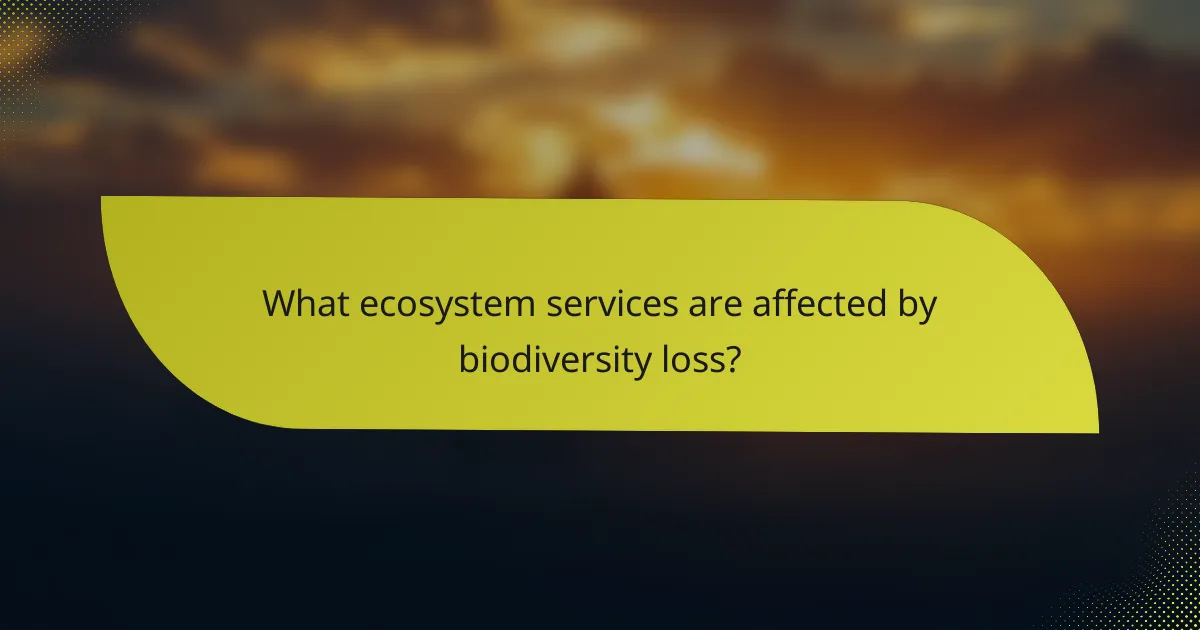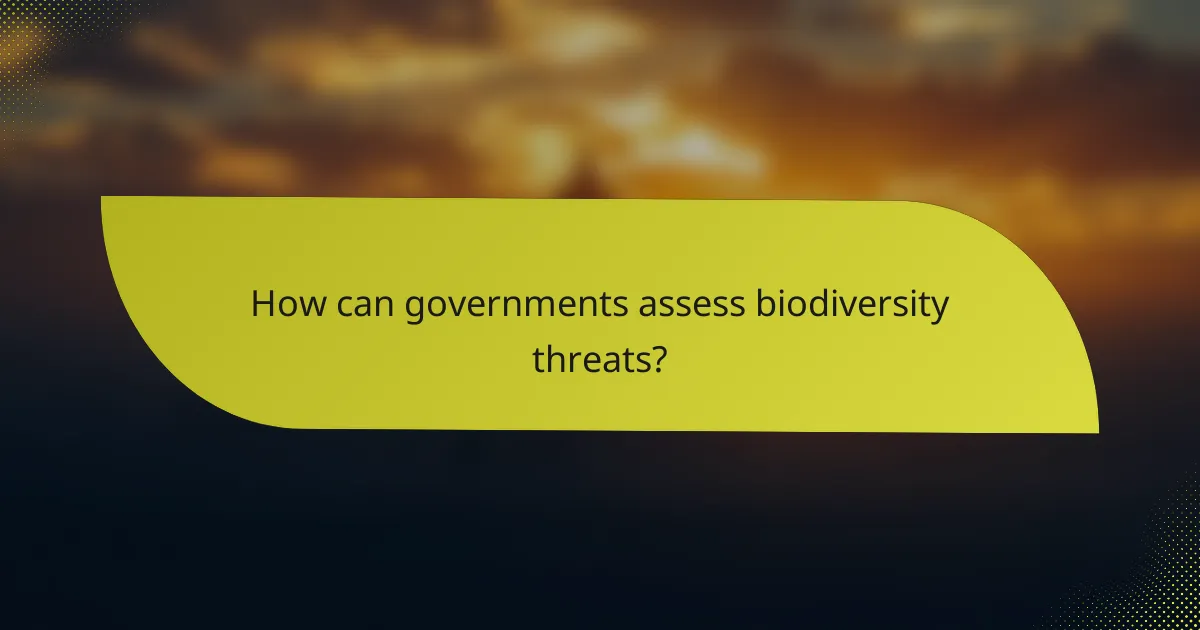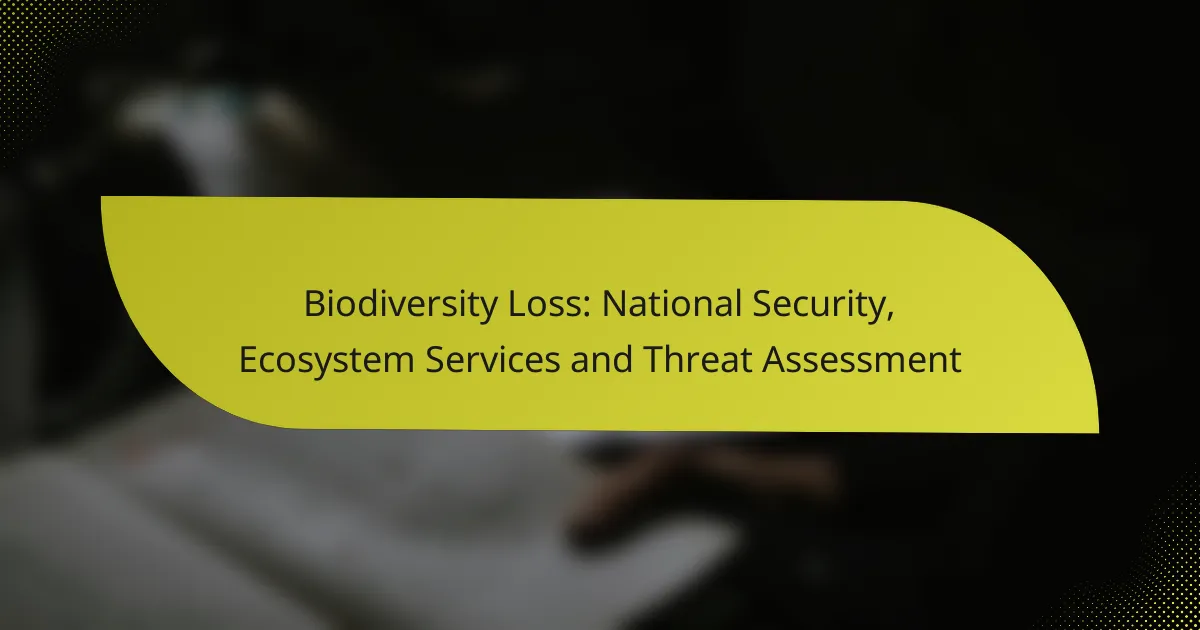Biodiversity loss poses a critical threat to national security by destabilizing ecosystems, leading to resource scarcity, heightened conflict, and public health challenges. This decline in biodiversity also jeopardizes essential ecosystem services, such as pollination and climate regulation, which are vital for human survival and environmental health. Addressing the key threats, including climate change and habitat destruction, is imperative to safeguard both natural ecosystems and human societies.

How does biodiversity loss impact national security?
Biodiversity loss significantly impacts national security by undermining ecosystem stability, which can lead to resource scarcity, increased conflict, and public health risks. These factors create vulnerabilities that can destabilize nations and threaten global peace.
Increased resource scarcity
The depletion of biodiversity leads to diminished natural resources, such as clean water, arable land, and raw materials. As ecosystems degrade, competition for these dwindling resources intensifies, particularly in regions already facing environmental stress.
For instance, areas dependent on specific crops may find their yields declining due to pest outbreaks or changing climate conditions, leading to shortages and increased prices. This scarcity can prompt governments to prioritize resource control, potentially leading to conflicts.
Heightened conflict risks
Biodiversity loss can exacerbate tensions between communities and nations, particularly over shared resources. As ecosystems collapse, groups may resort to conflict to secure access to water, land, or food, increasing instability in affected regions.
Historical examples include disputes over water rights in arid regions, where diminishing water sources have led to violence. Nations may also engage in military actions to secure resource-rich areas, raising the stakes for international relations.
Threats to food security
As biodiversity declines, agricultural systems become more vulnerable to pests and diseases, threatening food production. This instability can lead to food shortages, price spikes, and increased reliance on imports, which can strain national economies.
Countries with diverse agricultural practices tend to be more resilient to these threats. For example, crop rotation and polyculture can help mitigate risks associated with monoculture farming, ensuring a more stable food supply.
Public health vulnerabilities
Biodiversity loss can lead to increased public health risks as ecosystems that regulate disease vectors become unbalanced. The decline of certain species can result in the proliferation of pests and pathogens, heightening the risk of outbreaks.
For instance, the loss of natural predators can lead to higher populations of disease-carrying insects, which can spread illnesses like malaria or dengue fever. This not only affects public health but can also overwhelm healthcare systems and divert resources from other critical areas.
Economic instability
The economic implications of biodiversity loss are profound, as it can disrupt industries reliant on natural resources, such as agriculture, fisheries, and tourism. This disruption can lead to job losses, decreased income, and increased poverty levels.
Countries may face significant economic challenges if they cannot adapt to these changes. For example, nations that heavily depend on fishing may see their economies falter if fish populations decline due to habitat destruction, leading to a ripple effect across related sectors.

What ecosystem services are affected by biodiversity loss?
Biodiversity loss significantly impacts various ecosystem services that are crucial for human survival and environmental health. These services include pollination, water purification, climate regulation, soil fertility, and carbon sequestration, all of which are essential for maintaining ecological balance and supporting economies.
Pollination services
Pollination services are vital for the reproduction of many plants, including crops that humans rely on for food. Biodiversity loss can lead to a decline in pollinator populations, such as bees and butterflies, which can result in reduced crop yields and increased food scarcity.
To mitigate this, practices like planting diverse flowering plants and reducing pesticide use can help support pollinator health. Farmers should consider integrating pollinator-friendly habitats into their agricultural systems.
Water purification
Healthy ecosystems filter and purify water, removing pollutants and pathogens. Biodiversity loss can disrupt these natural filtration processes, leading to degraded water quality and increased treatment costs for communities.
Maintaining wetlands and riparian zones can enhance water purification. Communities should prioritize protecting these areas to ensure clean water supply and reduce the burden on water treatment facilities.
Climate regulation
Biodiversity plays a key role in regulating the climate by influencing carbon and nutrient cycles. Loss of species can weaken these systems, contributing to climate change and extreme weather events.
Restoring native vegetation and protecting forests can help enhance climate resilience. Individuals and organizations should engage in reforestation efforts and support policies that protect natural habitats.
Soil fertility
Soil fertility is maintained by a diverse array of organisms that contribute to nutrient cycling and soil structure. Biodiversity loss can lead to soil degradation, reducing agricultural productivity and increasing reliance on chemical fertilizers.
Practices such as crop rotation, cover cropping, and reduced tillage can help maintain soil health. Farmers should adopt these methods to enhance soil fertility and sustainability.
Carbon sequestration
Carbon sequestration involves capturing and storing atmospheric carbon dioxide, a critical process for mitigating climate change. Biodiverse ecosystems, particularly forests and wetlands, are more effective at sequestering carbon than monocultures.
To enhance carbon storage, land management strategies should focus on preserving existing forests and restoring degraded lands. Communities can participate in local conservation efforts to support these initiatives.

What are the key threats to biodiversity?
The key threats to biodiversity include climate change, habitat destruction, pollution, invasive species, and overexploitation of resources. Each of these factors contributes to the decline of ecosystems and the species that inhabit them, impacting both natural environments and human societies.
Climate change effects
Climate change significantly alters habitats and ecosystems, leading to shifts in species distribution and an increase in extinction rates. Rising temperatures, changing precipitation patterns, and extreme weather events can disrupt breeding and migration patterns for many species.
For example, coral reefs are highly sensitive to temperature changes, with even slight increases causing widespread bleaching. Protecting biodiversity requires strategies to mitigate climate change impacts, such as reducing greenhouse gas emissions and promoting sustainable land use practices.
Habitat destruction
Habitat destruction is primarily driven by urban development, agriculture, and deforestation, leading to the fragmentation of ecosystems. When natural habitats are converted for human use, many species lose their homes, resulting in population declines and increased vulnerability to extinction.
Efforts to combat habitat destruction include establishing protected areas, promoting sustainable land management, and restoring degraded ecosystems. For instance, reforestation initiatives can help recover lost habitats and support biodiversity.
Pollution impacts
Pollution, including chemical runoff, plastic waste, and air pollutants, poses severe risks to biodiversity. Contaminants can harm wildlife directly or disrupt food chains, leading to declines in species populations and ecosystem health.
Reducing pollution requires stricter regulations on waste management and industrial emissions. Community initiatives, such as clean-up drives and awareness campaigns, can also play a crucial role in minimizing pollution’s impact on local ecosystems.
Invasive species
Invasive species can outcompete native species for resources, disrupt local ecosystems, and introduce diseases. These non-native organisms often thrive in new environments due to a lack of natural predators, leading to significant biodiversity loss.
Preventing the introduction of invasive species involves strict regulations on trade and travel, as well as public education on the risks associated with releasing non-native species into the wild. Early detection and rapid response strategies are essential for managing existing invasions.
Overexploitation of resources
Overexploitation refers to the unsustainable use of natural resources, such as overfishing, logging, and hunting, which can deplete populations faster than they can recover. This practice threatens not only individual species but also the ecosystems that depend on them.
To address overexploitation, sustainable practices must be adopted, including setting catch limits in fisheries and promoting responsible consumption. Certification programs, like the Marine Stewardship Council, help consumers make informed choices that support sustainable resource management.

How can governments assess biodiversity threats?
Governments can assess biodiversity threats by implementing systematic approaches that evaluate risks to ecosystems and species. This involves using frameworks, data collection methods, and engaging stakeholders to create a comprehensive understanding of the threats faced.
Risk assessment frameworks
Risk assessment frameworks provide structured methodologies for identifying and evaluating biodiversity threats. Common frameworks include the IUCN Red List criteria, which categorize species based on their extinction risk, and the Ecosystem Services Framework, which assesses the impact of biodiversity loss on essential services like clean water and pollination.
Governments should consider integrating these frameworks into their environmental policies. This can help prioritize conservation efforts and allocate resources effectively, ensuring that the most vulnerable species and ecosystems receive attention.
Data collection methods
Effective data collection methods are crucial for assessing biodiversity threats. Governments can utilize remote sensing technologies, citizen science initiatives, and biodiversity monitoring programs to gather relevant data. For example, satellite imagery can track habitat changes, while citizen science can provide valuable observations of species populations.
It is essential to ensure that data collection is consistent and standardized. This allows for reliable comparisons over time and across different regions, helping to identify trends and emerging threats to biodiversity.
Stakeholder engagement strategies
Engaging stakeholders is vital for a comprehensive assessment of biodiversity threats. Governments should involve local communities, conservation organizations, and industry representatives in the assessment process. This collaboration can provide diverse perspectives and enhance the effectiveness of conservation strategies.
Regular workshops, public consultations, and collaborative research initiatives can foster stakeholder involvement. By building partnerships, governments can leverage local knowledge and resources, ultimately leading to more effective biodiversity management and threat mitigation.

What role do international agreements play in biodiversity conservation?
International agreements are crucial for biodiversity conservation as they establish frameworks for cooperation among nations to protect ecosystems and species. These agreements facilitate the sharing of resources, knowledge, and best practices, enabling countries to address biodiversity loss collectively.
Convention on Biological Diversity
The Convention on Biological Diversity (CBD) is a key international treaty aimed at conserving biological diversity, promoting sustainable use of its components, and ensuring fair sharing of benefits arising from genetic resources. Adopted in 1992, it has been ratified by nearly all countries, making it a cornerstone of global biodiversity efforts.
The CBD sets out commitments for countries to develop national strategies for biodiversity conservation, which include protecting natural habitats, restoring ecosystems, and integrating biodiversity considerations into sectoral policies. Countries are encouraged to report on their progress, fostering accountability and collaboration.
Practical steps under the CBD include creating protected areas, conducting biodiversity assessments, and engaging local communities in conservation efforts. For instance, nations may establish marine protected areas to safeguard ocean ecosystems, which can help sustain fisheries and tourism while preserving marine life.
